Biology - term 1 2025
1/91
There's no tags or description
Looks like no tags are added yet.
Name | Mastery | Learn | Test | Matching | Spaced |
|---|
No study sessions yet.
92 Terms
What are the seven characteristics of living things?
organisation, reproduction, metabolism, growth and development, evolution and adaption, responding to the environment, homeostasis
What does the 1st characteristic of living things mean?
Organisation - all living things are made up of one or more cells.
what are unicellular cells?
single celled organisms
What are multicellular organisms?
organisms made up of many cells
What does the 2nd characteristic of living things mean?
reproduction - the process by which an organism makes more of their own kind from one generation to the next
What does the 3rd characteristic of living things mean?
Metabolism - biochemical reactions occurring in an organism. Makes it possible for them to work, grow, reproduce and maintain structure.
What does the 4th characteristic of living things mean?
Growth and development - all living things increase in cell number and size (grow) and have the ability to change (develop)
What does the 5th characteristic of living things mean?
evolution and adaption - generic makeup may change/evolve over time to promote survival.
What does the 6th characteristic of living things mean?
responding to the environment - organisms respond to stimuli (changes) in their environment.
What does the 7th characteristic of living things mean?
Homeostasis - organism regulates its internal environment.
What is cell theory?
All living things are made up of cells, cells are the basic units of life, new cells arise from existing cells
What cell structure does prokaryotes have?
Simple cell structure without compartmentalisation (floating around)
What happens when prokaryotes reproduce?
creates two genetically identical daughter cells (clones)
What cell structure do eukaryotes have and what are the advantages?
Compartmentalized - efficiency of metabolism, localized conditions, toxic/damaging substances isolated
What are organelles?
A membrane bound structure found within a cell that performs a specific function.
What do organelles allow?
different functions to be compartmentalized in different areas of the cell
What is the cell membrane and what is its function?
The outer, permeable covering of a cell. Controls the entry and exit of materials, ensures the cell can regulate movement of materials to maintain homeostasis.
Where is the cell membrane located in animal cells?
Outer most layer of cell
Where is the cell membrane located in plant cells?
Just beneath cell wall
What are the important functions of the cell membrane?
Protective barrier, cell communication and recognition, cell attachment and adhesion
What does the cytoplasm do?
suspend cell organelles, maintain cell shape, contain dissolved substances and enzymes, site for reactions
what are ribosomes?
sites of protein synthesis (assembly); where proteins are made
what is the mitochondria and what is its function?
the powerhouse of the cell, to make a steady supply of ATP via cellular respiration
what are vacuoles and what is their function?
membrane-bound sac that stores water and nutrients, isolates hazardous materials, provides structural support
what is the cell wall and what is its function?
rigid covering surrounding the cell. Provides protection, support, gives cells its shape, prevents expansion and bursting of the cells, allows water to pass freely in and out of cell.
what are chloroplasts and what is their function?
organelles found in cytosol of plant cell, specialised to carry out reaction of photosynthesis.
what do lysosomes do?
contain powerful enzymes that break down (digest) harmful products, waste and invading organisms (eg: bacteria), act like recycling trucks
what is the currently accepted model of the cell membrane, and what does it depict its structure as?
fluid mosaic model, as a mosaic of phospholipids, cholesterol, proteins and carbohydrates.
what are the three components of the cell membrane?
phospholipids, proteins and cholesterol
what do phospholipids consist of?
a polar head (hydrophilic) composed of glycerol and two non-polar (hydrophobic) tails composed of fatty acids.
how is the head and tail of a phospholipid positioned and what does it form?
polar head is positioned out as it is attracted to water, and the non-polar tails in as they is repelled by water, forms a bilayer
where are protein molecules in cell membrane and what are their functions?
embedded within layers of phospholipids, help other molecules cross the membrane, respond to chemical signals, etc
what do protein channels do?
form a pore through the hydrophobic interior of the membrane to enable water soluble molecules to pass via facilitated diffusion
what does cholesterol do in relation to the cell membrane?
help the cell membrane maintain its shape by managing the space between phospholipids.
what does cell transport do and what does it include?
control the movement of substances across the plasma membrane, includes passive and active transport
what is passive transport?
transport of molecules through the cell membrane without an input of energy by the cell
what are the 3 kinds of passive transport?
simple diffusion, osmosis and facilitated diffusion
what is diffusion?
the movement of particles from an area of high concentration to an area with a lower concentration
what is a concentration gradient?
the difference in the concentration of molecules across a region
what are factors that speed up the rate of diffusion?
temperature (higher temp), surface area (larger surface), concentration gradient (higher gradient), distance (shorter distance), size of particles (smaller particles)
what is facilitated diffusion?
the diffusion of molecules through transport proteins in the plasma membrane
what happens during facilitated diffusion?
molecules move down their concentration gradient through carrier proteins or protein channels
what is osmosis?
the diffusion of water molecules across a selectively permeable membrane from an area of higher concentration to an area of lower concentration
what is the direction of osmosis driven by?
the concentration of solutes on either side of the membrane
what are the 3 types of cellular environments in osmosis?
hypertonic, hypotonic, isotonic
what does a hypertonic environment look like in osmosis?
higher concentration of solute molecules outside of cell, lower concentration of solute molecules inside of cell
what happens during a hypertonic environment in osmosis?
water moves out of cell to region of higher solute concentration until both solutions are balanced, loses water in result
what does a hypotonic environment look like in osmosis?
lower concentration of solute molecules outside of cell, higher concentration of solute molecules inside of cell.
what happens during a hypotonic environment in osmosis?
water moves into the cell to the region of higher solute concentration until both solutions are balanced, cell gains water in result.
what does an isotopic environment look like in osmosis, and what occurs?
solution is equal on inside and outside of cell, cell maintains its normal shape and form
what is active transport?
energy-requiring process that moves substances across the cell membrane against their concentration gradient
what direction does the substances move during active transport?
across cell membrane from an area of lower concentration to an area of higher concentration
how do substances move during active transport?
by being pumped across membrane using carrier proteins
what is bulk transport used for?
to move very large molecules and large quantities that will not fit through the plasma membrane or move through carrier proteins.
how does bulk transport occur?
substance is enclosed in vesicles to be transported
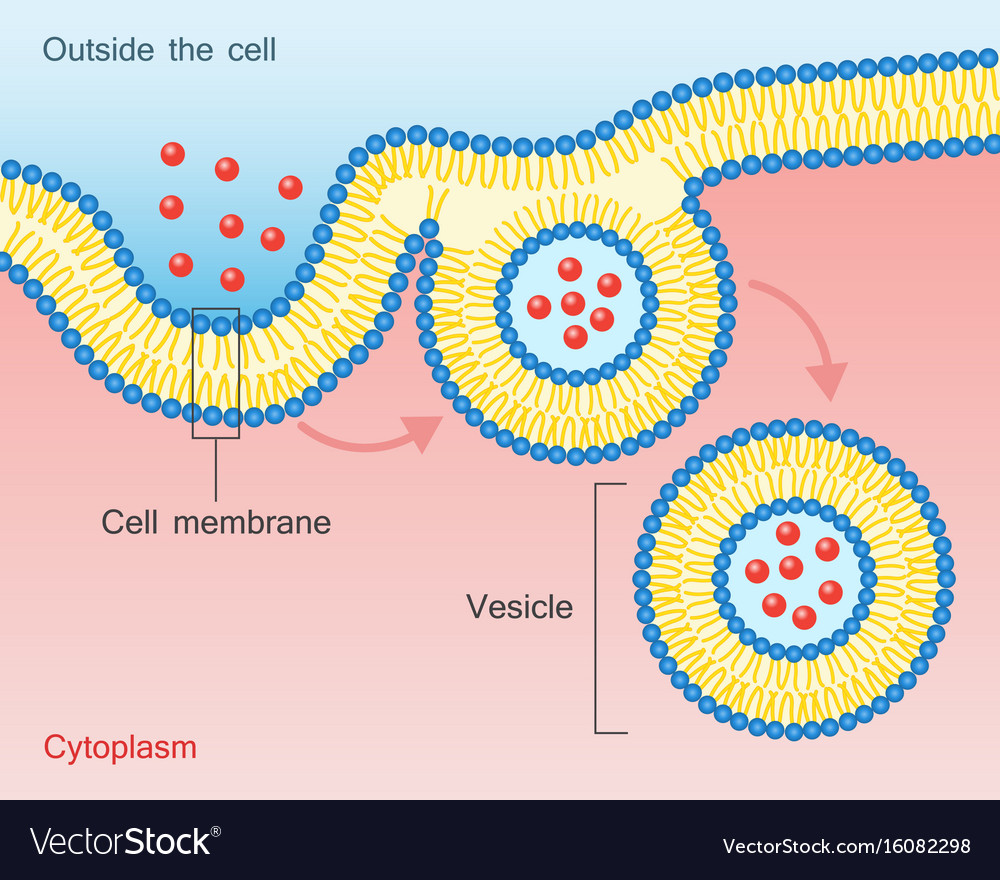
what type of bulk transport is this?
endocytosis
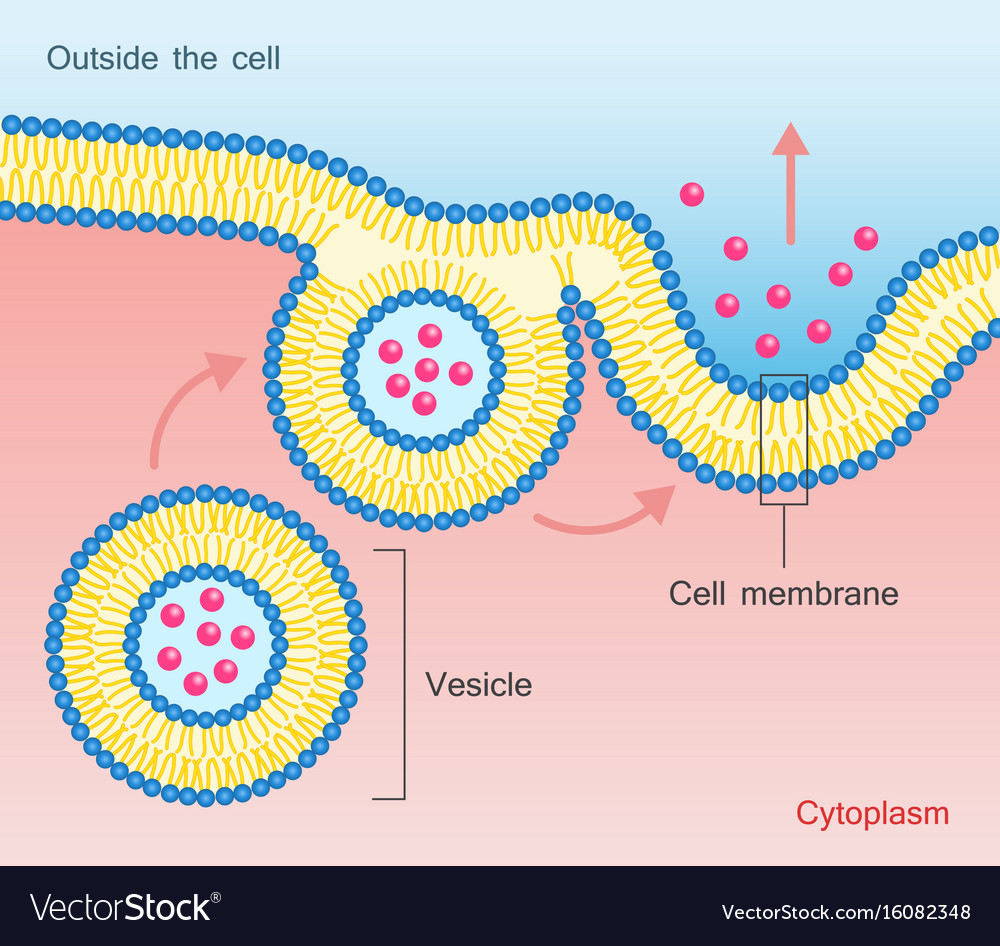
what type of bulk transport is this?
exocytosis
what are two main focuses of bulk transport?
endocytosis and exocytosis
what does endocytosis do?
moves particles into a cell by enclosing them inside a vesicle, “enter cell”
what does exocytosis do?
materials are transported from the inside to the outside of the cell in vesicles, “exit cell”
what is cell division?
process in which one cell (parent cell) divides to form two or more new daughter cells
what are the purposes of cell division?
development, growth, repair, reproduction.
what is mitosis?
the process in which one cell (parent cell) divides into two genetically identical daughter cells, where each daughter has two sets of chromosomes (diploid)
what is the first step of mitosis and what happens?
interphase, cell prepares for cell division, where it undergoes DNA replication
what is the second step of mitosis and what happens?
prophase, DNA condenses and coils into visible chromosomes, spindle fibers form and attach to centromere, nuclear envelope breaks down.
what is the 3rd step of mitosis and what happens?
metaphase, chromosomes are pulled by the spindle fibers and lined up at the centre (middle) of the cell
what is the 4th step of mitosis and what happens?
anaphase, sister chromatids are pulled to opposite poles (ends) of the cell by the shortening of spindle fibers (apart)
what is the 5th step of mitosis and what happens?
telophase. two new nuclei form - one for each set of chromosomes, nuclear membranes reform, chromosomes begin to uncoil, spindle fibers break down.
what is the 6th step of mitosis and what happens?
cytokinesis, parent cell is cleaved in half

what stage of mitosis is this?
prophase
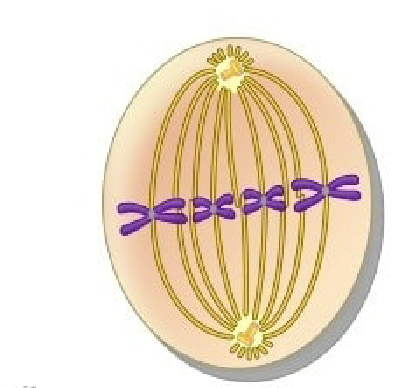
what stage of mitosis is this?
metaphase
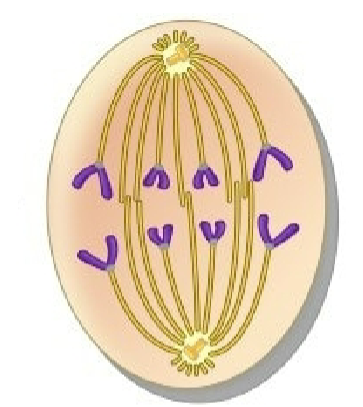
what stage of mitosis is this?
anaphase
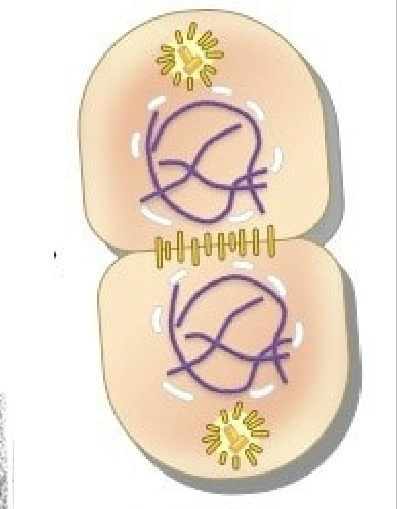
what stage of mitosis is this?
telophase
how do you calculate actual size in relation to microscopes?
image size / magnification
how do you calculate image size in relation to microscopes?
actual size x magnification
how do you calculate magnification in relation to microscopes?
image size / actual size
what are features of prokaryotic cells?
lack internal membrane bound organelles, do not have a nucleus, significantly smaller than eukaryotes, usually have a single circular chromosome, exist as simple cells.
what are examples of prokaryotic cells?
bacteria and archaea
what are examples of eukaryotic cells?
plants, animals, fungi

what type of osmosis environment is this?
hypotonic
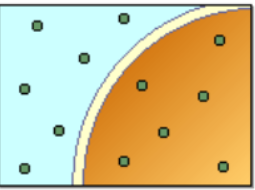
what type of osmosis environment is this?
isotonic
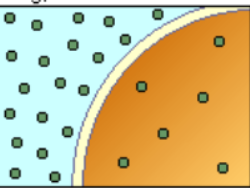
what type of osmosis environment is this?
hypertonic
what does the term living mean?
any life form that possesses or shows the characteristics of living things
what does surface area mean?
the outside area of a cell exposed to the external environment
what does surface area affect? (in relation to passive transport)
the rate at which particles can enter and exit the cell
what does volume mean?
the amount of space inside of the cell
what does volume affect? (in relation to passive transport)
the rate at which material is made or used within the cell
what happens as size of the cell increases? (in relation to passive transport)
surface area to volume ratio decreases/gets smaller
what happens if surface area to volume ratio gets too small? (due to cell size increase)
substances will not be able to exit and enter the cell fast enough, centre of cell will not receive substances it needs to function
how do you calculate surface to volume ratios?
find the surface area by finding area of cube side and multiplying it by 6, find volume by multiplying cube size by 3.
what size surface area to volume ratio do small cells have?
large
what size surface area to volume ratio do large cells have?
small